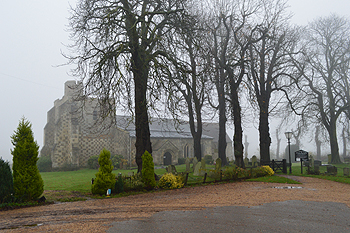Chalgrave Chantry

Chalgrave church on a misty morning, November 2014
Volume III of The Victoria County History for Bedfordshire, published in 1912, gives details of a chantry at Chalgrave. This was not a separate building as the prayers said by the chantry priests would have been made in the church. However, there was a building called The Chantry House and this is, presumably, where the chantry priests lived.
A chantry was granted to Lord of the Manor of Chalgrave, Peter Loring in 1273 by Dunstable Priory. This means that the priory sent one of its canons to Chalgrave to serve as a chantry priest. This individual would have been in addition to the parish priest and his function would have been to say prayers for a dead benefactor or benefactors, in this case Loring himself and his family. It was believed that saying prayers for the dead lessened their stay in a place called Purgatory, somewhere in between Heaven and Hell where souls would be subjected to pain in order to purge their sins before being fit to enter Heaven. In addition to saying prayers for the dead the chantry priest might have had some other limited functions such as teaching children or assisting the parish priest when needed. Some churches had specific chantry chapels in which the chantry priest would say his offices at the chapel’s altar, otherwise he would simply use the main altar or another subsidiary altar already existing in the church.
When Sir Nigel Loring died about 1386 he had the Bishop of London as his executor. For several years the bishop, at his own expense, funded three chantry chaplains. This is a surprisingly large number of priests for so small a place as Chalgrave and speaks volumes for the importance of Sir Nigel himself. A licence for the creation of a chantry with three priests was granted in 1406. Three years later the church at Offley [Hertfordshire] was appropriated to help fund the chantry. In 1531 the chantry was obtained by Richard Hatton. Nine years later Dunstable Priory was dissolved by Henry VIII (1509-1547). At this time chantries were banned as their theology did not agree with the new churchmanship introduced during the Reformation. The priests’ house, called the Chantry House, was given by Edward VI (1547-1553) to Henry Parker and Peter Grey and it is last mentioned in 1586.
The Bedfordshire Historic Environment Record [HER] contains information on the county’s historic buildings and landscapes and summaries of each entry can now be found online as part of the Heritage Gateway website. The entry for the chantry at Chalgrave [HER 11803] states that the Chantry House occupied the site of the later Church Farm, which stood just east of the church but was subsequently demolished in the early 20th century.
A deed of 1822 [ref: P103/2/2] includes the site of a mansion house called The Chauntry near Chalgrave Church, “then pulled down and part converted into a house in the occupation of Mr. Inward”. It is possible that this building was the medieval mansion of the Manor of Chalgrave, though this may have been elsewhere, perhaps on or near the site of today's Manor Farm. In 1535 the chantry priests were recorded as having possession of a number of pieces of land which gave income to support them as well as a mansion called “Old Orchard” with a garden, dovecote, close and four acres of land. It seems likely that Old Orchard and The Chauntry were one and the same.